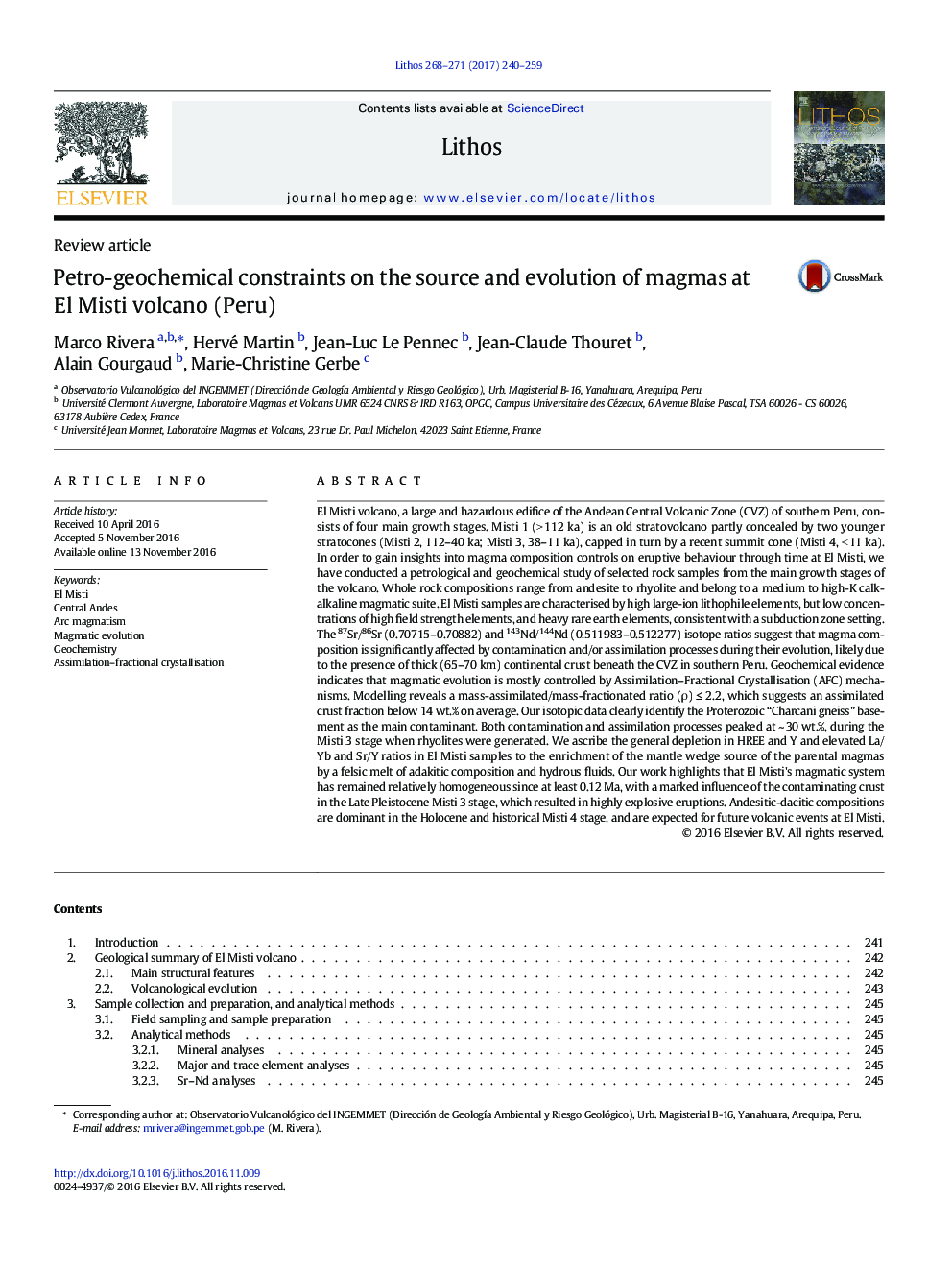| کد مقاله | کد نشریه | سال انتشار | مقاله انگلیسی | نسخه تمام متن |
|---|---|---|---|---|
| 5784332 | 1638637 | 2017 | 20 صفحه PDF | دانلود رایگان |
- El Misti medium-high-K calk-alkaline suite range from andesites to rhyolites (SiO2 57-74 wt.%).
- Trace elements and isotope ratios (87Sr/86Sr, 143Nd/144Nd) indicate crustal contamination-assimilation processes particularly between 38 and 11Â ka.
- Geochemical modelling shows that AFC has controlled the petrogenetic evolution.
- The amount of assimilated crust from the Proterozoic basement does not exceed 14 wt.%.
- The source of the parental magmas point to a mantle wedge peridotite modified by adakitic melts.
El Misti volcano, a large and hazardous edifice of the Andean Central Volcanic Zone (CVZ) of southern Peru, consists of four main growth stages. Misti 1 (> 112 ka) is an old stratovolcano partly concealed by two younger stratocones (Misti 2, 112-40 ka; Misti 3, 38-11 ka), capped in turn by a recent summit cone (Misti 4, < 11 ka). In order to gain insights into magma composition controls on eruptive behaviour through time at El Misti, we have conducted a petrological and geochemical study of selected rock samples from the main growth stages of the volcano. Whole rock compositions range from andesite to rhyolite and belong to a medium to high-K calk-alkaline magmatic suite. El Misti samples are characterised by high large-ion lithophile elements, but low concentrations of high field strength elements, and heavy rare earth elements, consistent with a subduction zone setting. The 87Sr/86Sr (0.70715-0.70882) and 143Nd/144Nd (0.511983-0.512277) isotope ratios suggest that magma composition is significantly affected by contamination and/or assimilation processes during their evolution, likely due to the presence of thick (65-70 km) continental crust beneath the CVZ in southern Peru. Geochemical evidence indicates that magmatic evolution is mostly controlled by Assimilation-Fractional Crystallisation (AFC) mechanisms. Modelling reveals a mass-assimilated/mass-fractionated ratio (Ï) â¤Â 2.2, which suggests an assimilated crust fraction below 14 wt.% on average. Our isotopic data clearly identify the Proterozoic “Charcani gneiss” basement as the main contaminant. Both contamination and assimilation processes peaked at ~ 30 wt.%, during the Misti 3 stage when rhyolites were generated. We ascribe the general depletion in HREE and Y and elevated La/Yb and Sr/Y ratios in El Misti samples to the enrichment of the mantle wedge source of the parental magmas by a felsic melt of adakitic composition and hydrous fluids. Our work highlights that El Misti's magmatic system has remained relatively homogeneous since at least 0.12 Ma, with a marked influence of the contaminating crust in the Late Pleistocene Misti 3 stage, which resulted in highly explosive eruptions. Andesitic-dacitic compositions are dominant in the Holocene and historical Misti 4 stage, and are expected for future volcanic events at El Misti.
Journal: Lithos - Volumes 268â271, January 2017, Pages 240-259
